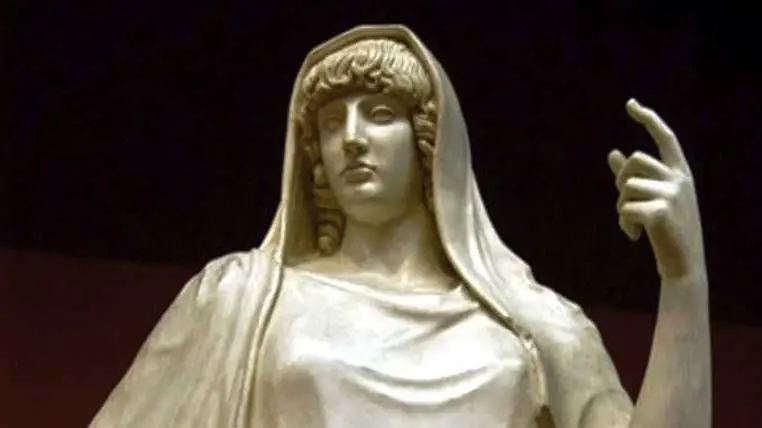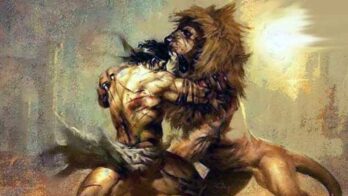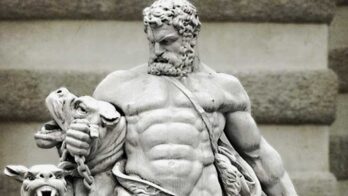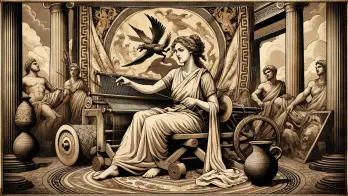In Greek mythology, Hestia represented the ideal feminine, characterized by intelligence, attentiveness, and discretion, as perceived by early Greek society.
She was also recognized as the supreme matron, symbolizing the order and tranquility of each household.
Although Poseidon and Apollo both sought her hand in marriage, Hestia secured the right to maintain her virginity forever from Zeus, the Lord of Olympus.
The exceptional honors granted by Zeus made her cult one of the most important in Ancient Greece.
Venerated in both private and public spheres, the Greek goddess of the hearth was symbolized by the fireplace in each household and in the Prytaneum, a public building at the center of every Greek polis.
Etymology
The word “Hestia” originates from the Greek word for “hearth” or “fireplace,” which was an appropriate symbol for the domestic goddess.
The etymology of her name remains, however, somewhat obscure. Still, some linguists have suggested connections to Proto-Indo-European roots, while others propose links to other words for “hearth,” such as the Greek “eschara” and the Slavic “jestěja.”
However, Robert S. P. Beekes argues that the name “Hestia” is most likely pre-Greek in origin.
Characterization
Despite her essential role in the Pantheon of Greek gods, there is little information about Hestia’s personality and mythology. However, the Homeric Hymns, religious poems dedicated to the Greek gods, provide insight into her character.
In Hymn Twenty-Four, Hestia is referred to as “the one who takes care of the holy house of Lord Apollo, the distant ancestor of the good Pytho, with holy oil constantly dripping from your hair.”
And in Hymn Twenty-Nine, she is described as living “in the high houses of all, both the eternal gods and the mortals who walk the earth.”
In ancient Greek art and mythology, the goddess was often portrayed as a modestly dressed, veiled woman with a scepter or a torch. She was often depicted sitting at the hearth, with the sacred flame burning before her.
As the goddess of the hearth, home, and family, Hestia did not possess the same physical strength or combat abilities as some of the other Greek gods and goddesses.
Instead, her power lay in her role as the protector of the home and in her association with the sacred flame, which represented the heart of the family and community.
Hestia was also seen as a goddess of hospitality and peace; her temples were considered sanctuaries where all could find refuge and protection.
She was revered as a symbol of stability and continuity, and her worship played an essential role in maintaining the social fabric of ancient Greek society.
Unlike her more famous siblings, she was a modest and hard-working goddess who rarely appeared in the tumultuous tales of Greek mythology. Instead, she devoted herself to her duties as the protector of the family and the hearth.
However, there is some debate among scholars as to whether Hestia should be counted among the twelve great Olympian gods of Greek mythology.
In some depictions of the Olympian Pantheon, she is replaced by the god Dionysos.
For example, on the east frieze of the Parthenon, an enormous temple dedicated to the goddess Athena, Dionysos is shown among the twelve Olympians, while the goddess is not depicted.
On the other hand, the altar dedicated to the twelve fundamental gods of the Greek Pantheon in Athens features the image of Hestia, but not Dionysos.
Some scholars suggest that this interchange of places between Hestia and Dionysos reflects the peaceful and generous nature of the goddess, who was willing to give up her place in the Pantheon to prevent a conflict between the gods.
However, it should be noted that this interpretation is not based on any specific myth or legend but rather a modern conjecture.
Symbolism
Hestia represented the purifying fire that burns diseases and plagues, the mild fire of the hearth on which people cooked their food, providing light at night and warmth in winter.
Her flame symbolized the purity and innocence of the household, untainted by deceit, intrigue, or animosity.
Before any sacrifice in honor of a god, people were required to first perform a sacrifice accompanied by songs dedicated to the goddess.
Her right to be praised in every temple and household in Greece was granted due to her purity and innocence. Thus, she was an essential deity in ancient Greek religion and is a significant figure in mythology today.
The Meaning Behind Hestia Symbols
Hestia is represented by various symbols reflecting her personality traits and contribution to civilization. Her symbols include the sacred flame, architecture, household items, animals, plants, scents, gems, metals, and colors.
One of her most significant symbols is the hearth, which represents warmth, security, protection, family, and home. As the goddess of home and sacred fire, the hearth is a fitting symbol for the goddess.
Apart from the hearth, other symbols associated with Hestia are architecture, bowls, veils, pantries, and keys. These symbols reflect her contribution to architecture, personal households, and civilization as a whole.
Regarding animals, donkeys and pigs have particular significance in Hestia’s symbolism. Donkeys symbolize honesty, diligence, courage, and truth, while pigs represent fertility and success in business and careers.
Plants and flowers that symbolize Hestia include the angel’s trumpet (Datura), hollyhock, purple coneflower, and yarrow. These plants embody the goddess’s connection to nature and the natural world.
Her associated scents and perfumes include angelica root, iris, lavender, and peony. Of these scents, angelica root is the most fitting for Hestia, with its musky, earthy, and warm aroma.
Gems and metals associated with Hestia include amethyst, garnet, gold, silver, and brass. Amethyst, in particular, symbolizes purity, protection, wisdom, humility, and healing, all traits that align with her character.
Finally, as the goddess of the sacred fire, gold is the most logical color to symbolize Hestia. Other colors associated with the goddess are dark rose, lavender, silver, and black.
Hestia symbols represent her contribution to home and personal households, architecture, civilization, and the natural world.
These symbols embody her personality traits, such as honesty, courage, wisdom, and connection to the sacred flame and the natural world.
Genealogy
Hestia, the first-born child of the Titans Cronos and Rhea, played a crucial role in Greek mythology as the goddess of family and the hearth. Along with her siblings, Zeus, Poseidon, Hades, Hera, and Demeter, She was swallowed by her father, Cronos, who feared that one of his children would overthrow him.
However, she was later freed by Zeus, who defeated Cronos and made him disgorge all of his swallowed progeny.
Parents
- Cronos: The titan god of time and the ages, he was the son of Uranus (the sky) and Gaia (the earth). Cronos overthrew his father and ruled during the Golden Age, but he was later overthrown by his own son Zeus.
- Rhea: The titan goddess of fertility, motherhood, and generation, she was the daughter of Uranus and Gaia. Rhea was known for being the mother of the Olympian gods, protecting them from Cronos by hiding them and giving him stones instead of babies to swallow.
Siblings
- Zeus: The king of the gods, Zeus was the youngest son of Cronos and Rhea. He overthrew his father and became the ruler of the cosmos, governing the sky, lightning, thunder, and justice.
- Poseidon: The god of the sea, earthquakes, and horses, Poseidon was the elder brother of Zeus. He was known for his temper and trident, which he used to create storms and earthquakes.
- Hades: The god of the underworld and the dead, Hades was the eldest son of Cronos and Rhea. He was known for his wealth and helmet of invisibility, which he used to avoid the gaze of the living.
- Hera: The queen of the gods and the goddess of marriage, childbirth, and family, Hera was the wife of Zeus and the sister of both him and Poseidon. She was known for her jealousy and her wrath towards Zeus’ mistresses.
- Demeter: The goddess of agriculture, fertility, and the harvest; Demeter was the sister of Zeus, Poseidon, Hades, and Hera. She was known for her association with the earth and the seasons and for her grief over losing her daughter Persephone to Hades.
Myths and Legends
Compared to some other significant gods and goddesses in Greek mythology, there are relatively few myths about Hestia.
This is because she was not a very active or involved deity, and her worship focused more on maintaining the sacred fire in the home rather than on epic stories or heroic feats.
Birth
Hestia, the eldest daughter of the Titans Rhea and Cronus, is a goddess of the first Olympian generation. She has five siblings – Demeter, Hades, Hera, Poseidon, and Zeus.
According to the myth, Cronus swallowed all his children immediately after their birth, with Hestia being the first to be consumed.
However, Zeus was saved by Rhea, the youngest and the last child. Later, Zeus led a war against their father and other Titans, forcing Cronus to disgorge his siblings.
As “first to be devoured . . . and the last to be yielded up again”, Hestia is thus both the eldest and youngest daughter; this mythic inversion is found in the Homeric Hymn to Aphrodite (700 BC).
Zeus assigned a significant duty to Hestia – to maintain and feed the fires of the Olympian hearth with the fatty and combustible portions of animal sacrifices to the gods.
The Virgin Goddess
A more comprehensive legend about the Greek goddess of hearth can be found in the fifth Homeric hymn, which pays homage to the Greek goddess of love and beauty, Aphrodite.
This hymn portrays the goddess as a chaste virgin, starkly contrasting with Aphrodite, the goddess of promiscuity and sexual pleasure. Essentially, she becomes an anti-Aphrodite figure.
Hestia’s dedication to virginity was so absolute that even two of the most eligible suitors in the universe, Poseidon and Apollo, were rejected when they proposed to marry her. As the fifth Homeric hymn recounts:
No maiden as pure as her, a queen whom both Poseidon and Apollo sought to marry, loves the works of Aphrodite. But she refused steadfastly, and touching the head of Zeus, who holds the Aegis, the lovely goddess, swore a great oath that indeed came true, that she would be a virgin in all her days.
Hestia and Priapus
Another tale attributed to the first-century AD Greek writer and philosopher Ovid tells of how Priapus, an insignificant fertility god only known in a few settlements in southern Greece, threatened the virginity of Hestia.
After the Olympians triumphed over the Titans, Gaia, the mother goddess of the earth, threw a party in honor of the victors. Disinterested in the festivities, she retired to the nearby woods and fell asleep.
In the dead of night, the drunken Priapus, known for his insatiable sexual appetite, stumbled upon the sleeping goddess.
He was smitten by her beauty and attempted to abduct her, but a braying ass woke her up, and she began to scream.
When the other Olympians arrived, they scolded Priapus harshly and banned him from joining in their festivities and festivals again.
Hestia retained her coveted virginity, and Priapus was exiled to live with the satyrs in the wilderness for all eternity.
The Cult of Hestia
Although the cult of Hestia is rarely mentioned today, it was widespread throughout Ancient Greece, and the goddess was greatly beloved by the Greeks.
Worship
Hestia’s worship revolved around the hearth, which was crucial for warmth, food preparation, and the completion of offerings to the gods, both in domestic and civic settings.
During feasts, Hestia was offered the first and last libations of wine. According to Pausanias, the Eleans offered sacrifices first to her and then to other gods.
At the same time, Xenophon recorded that Cyrus the Great sacrificed first to Hestia, then to sovereign Zeus, and finally to any other god that the magi suggested.
Failing to maintain a domestic hearth fire represented a failure in both domestic and religious care for the family. Neglecting to maintain Hestia’s public fire in her temple or shrine was a breach of duty to the broader community.
While a hearth fire could be deliberately and ritually extinguished, its lighting should be accompanied by completion, purification, and renewal rituals, similar to the practices and connotations of an eternal flame and sanctuary lamps.
Typically, the responsibility for Hestia’s domestic cult was delegated to the leading woman of the household, although sometimes a man was in charge.
Civil officeholders usually led Hestia’s rites at public buildings’ hearths. Dionysius of Halicarnassus testified that the Prytaneum of a Greek state or community was sacred to Hestia and was served by the most powerful state officials.
While evidence of her dedicated priesthood is rare, most stem from the early Roman Imperial era.
Women with the priestly title “Hestia” were found in Sparta, and Chalcis had one, a daughter of the local elite.
Hestia’s political and civic functions are further evidenced by her numerous privately funded dedications at civic sites and the administrative titles used by the lay officials involved in her civic cults.
Shrines, Temples, and Colonies
In ancient times, every household’s private and public hearth was considered sacred to the goddess, and a portion of all sacrifices made to any deity was offered to her.
Aeschines’ “On the Embassy” asserts that the Prytaneum’s hearth was regarded as the state’s common hearth, and a statue of Hestia was present there.
Furthermore, the senate house contained an altar dedicated to the goddess.
Hestia Boulaea, also known as “of the Senate” or boule, had a temple in Ephesus. Pausanias reported that a figurative statue of Hestia and one of the goddesses Eirene (“Peace”) were present in the Athenian Prytaneum.
Hestia offered sanctuary to those who respected her and punished those who offended her.
Diodorus Siculus wrote that Theramenes sought asylum from Hestia directly at the Council Chamber by leaping onto her hearth, not to save himself but rather to show the impiety of his slayers by killing him there.
Very few independent temples were built specifically for her.
Pausanias mentioned two such temples, one in Ermioni and the other in Sparta, the latter only containing an altar and no image.
Xenophon’s Hellenica described fighting both in and around Olympia’s temple of Hestia, a separate building from the city’s council hall and adjoining theatre. Additionally, a temple to Hestia existed in Andros.
When founders of city-states and colonies were seeking approval and guidance, they turned not only to their “mother city” (represented by Hestia) but also to Apollo through one of his various oracles.
Apollo served as a consulting archegetes, or founder, at Delphi. Among his many functions, he was the patron god of colonies, architecture, constitutions, and city planning.
Vesta in Roman Mythology
The Roman equivalent of Hestia was Vesta.
In Roman mythology, Vesta was the goddess of the hearth, home, and family. She was also the guardian of the sacred fire that burned in the temple dedicated to her in Rome, known as the Temple of Vesta.
In ancient Rome, Vesta was worshipped through the Vestal Virgins, who were chosen as young girls and trained to serve in her temple for 30 years.
They were responsible for maintaining the sacred fire, performing rituals and sacrifices, and weaving the sacred cloth that adorned Vesta’s statue. The Vestal Virgins were highly respected and important to Rome’s well-being.
Vesta was portrayed in Roman mythology as a virgin goddess, often shown wearing a long dress and a veil that covered her head.
She was also depicted carrying a scepter or a cornucopia, symbolizing her role as a guardian of the hearth and provider of abundance.
She is shown with a flame or torch in some depictions, representing the sacred fire she protects.
At Ancient Theory we only use trusted sources to document our articles. Such relevant sources include authentic documents, newspaper and magazine articles, established authors, or reputable websites.
- Christopher Sailus - The Greek Goddess Hestia: Mythology & Facts. [Source]
- Hestia. wikipedia.org. [Source]
- William Smith - A Dictionary of Greek and Roman Biography and Mythology. Murray, 1849.
- Mary R. Lefkowitz and Maureen B. Fant - Women's Life in Greece and Rome: A Sourcebook in Translation. Johns Hopkins University Press, 2005.
- Henk S. Versnel - Inconsistencies in Greek and Roman Religion, Vol. I: Ter Unus. Brill, 1990.
- Timothy Gantz - Early Greek Myth: A Guide to Literary and Artistic Sources. Johns Hopkins University Press, 1993.






